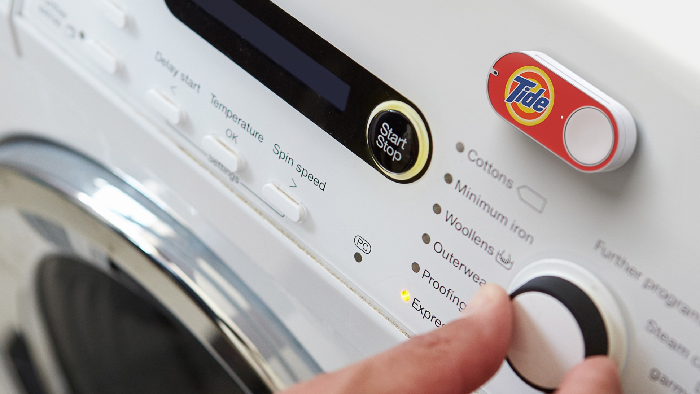The Rise of Contextual Commerce
At its simplest level, the concept of “contextual commerce” is easy to understand: Put your products or services in front of your customers at the exact moment they need them. This is why taxis prowl the bar scene at 2:30 a.m. or that industrious kid on your block sells Kool-Aid on 90-degree days.
Recent advances in technology have made it easier than ever to put your product right in the customer’s face. Not by physically having the product in reach, but rather by making the purchasing mechanism quicker and easier.
The Amazon Dash Button is the best and most recent example. For $5 (reimbursed with your first order) you get a Wi-Fi enabled device about the size of a flash drive. The device has a single button on it that, when pushed, automatically ships a pre-defined quantity of your favorite product straight to your doorstep.
Currently available from about 30 brands, you can get baby food, soft drinks, gum, laundry detergent, trash bags and a host of other consumable products… just by pushing a button. Simply stick the button where you need it and forget about it. Next time you do laundry and you use the last of the detergent? Push the Tide button stuck to your washing machine. Down to the last four diapers? Push the Huggies button stuck to the changing table. Dangerously low on coffee? Push the Maxwell House button inside your cabinet.

The Amazon Dash Button is just the latest in a growing trend away from the traditional Sunday shopping trip. Services like Amazon Prime and Peapod make it increasingly easy to order what you need and have it delivered… no trip to the store—any store—required.
What does this mean for brands? It means that earning and keeping customer preference and loyalty is more important than ever. Once the Tide button is in place, and the consumer is habitually using it, it will be nearly impossible for Purex or Cheer to knock them out of place. Brands that connect with their customers in real and meaningful ways will be best positioned as the shopping experience moves away from brick and mortar and online to inside the cabinet.
Recent advances in technology have made it easier than ever to put your product right in the customer’s face. Not by physically having the product in reach, but rather by making the purchasing mechanism quicker and easier.
The Amazon Dash Button is the best and most recent example. For $5 (reimbursed with your first order) you get a Wi-Fi enabled device about the size of a flash drive. The device has a single button on it that, when pushed, automatically ships a pre-defined quantity of your favorite product straight to your doorstep.
Currently available from about 30 brands, you can get baby food, soft drinks, gum, laundry detergent, trash bags and a host of other consumable products… just by pushing a button. Simply stick the button where you need it and forget about it. Next time you do laundry and you use the last of the detergent? Push the Tide button stuck to your washing machine. Down to the last four diapers? Push the Huggies button stuck to the changing table. Dangerously low on coffee? Push the Maxwell House button inside your cabinet.

The Amazon Dash Button is just the latest in a growing trend away from the traditional Sunday shopping trip. Services like Amazon Prime and Peapod make it increasingly easy to order what you need and have it delivered… no trip to the store—any store—required.
What does this mean for brands? It means that earning and keeping customer preference and loyalty is more important than ever. Once the Tide button is in place, and the consumer is habitually using it, it will be nearly impossible for Purex or Cheer to knock them out of place. Brands that connect with their customers in real and meaningful ways will be best positioned as the shopping experience moves away from brick and mortar and online to inside the cabinet.
Have a question on how this rise of contextual commerce will affect your brand? Contact us!
Contact us today! No pressure, but we are here to help
Reach out to learn more about how thunder::tech can help your business not only succeed, but accelerate.